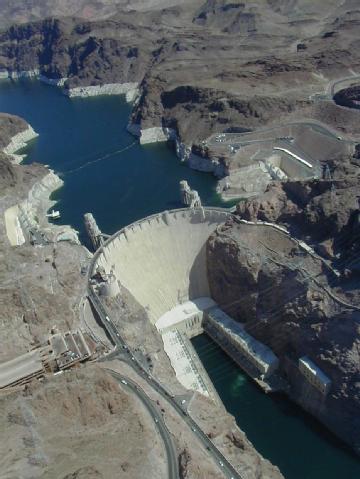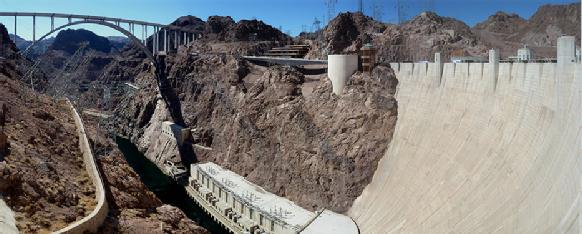
Hoover Dam Visitor Center |
89005 Boulder City, NV, United States of America (USA) (Nevada) |
|
| Address |
|
| Floor area | unfortunately not known yet |
Electric motors/generators/pumps
- Historic Engineering Landmarks
|
Opening times
|
9am - 6pm; First Powerplant Tour departs at 9:25am | ||||
|
Status from 04/2017
|
Powerplant Tour (30-min): Adults (ages 17-61): $15; Seniors, Juniors (ages 4-16), U.S. Military: $12
Hoover Dam Tour (1-hour): $30 |
||||
| Contact |
|
||||
| Homepage | www.usbr.gov/lc/hooverdam | ||||
| Location / Directions |
Hoover Dam is located approximately 30 miles southeast of Las Vegas, on the Nevada-Arizona border. The Dam does not have a street address, so directions are provided below. from Las VegasAbout 30 miles/45 minutesTake US Highway 93 South and continue about 20 miles to Boulder City In Boulder City, take a left at the second stoplight in town (there are only 2 of them) Continue on US 93 for about 5 miles (just past the Hacienda Hotel) to the turn-off to Nevada State Route 172 - the Hoover Dam Access Road Take NV SR 172 for about 2 miles to the Dam on the Nevada/Arizona border (Note: Visitors who wish to continue travel into Arizona must re-enter Nevada and access Highway 93 to cross the Hoover Dam Bypass Bridge; the roadway across Hoover Dam is no longer open to through-traffic.) Traffic Advisory: Motorists can expect periodic delays on Highway 93, especially during holiday travel times. Also, all vehicles are required to undergo a security inspection prior to crossing the dam. See our publication "Visiting Hoover Dam: A Traveler's Guide" (Adobe Acrobat file - 45 KB) for more information. Parking at the DamA 459-space parking garage is located on the Nevada side of the dam set into a canyon across the road from the Visitor Center. The parking garage charges a $7.00 fee.Upon Arrival at the Visitor CenterFrom the parking garage, walk toward the dam. A short distance from the garage you will find both an escalator and elevator that will take you down to a reception lobby where you can purchase your tickets. |
| Description | The Story of Hoover DamHoover Dam is a testimony to a country's ability to construct monolithic projects in the midst of adverse conditions. Built during the Depression; thousands of men and their families came to Black Canyon to tame the Colorado River. It took less than five years, in a harsh and barren land, to build the largest dam of its time. Now, years later, Hoover Dam still stands as a world-renowned structure. The Dam is a National Historic Landmark and has been rated by the American Society of Civil Engineers as one of America's Seven Modern Civil Engineering Wonders. Hoover Dam Historical CollectionThe Bureau of Reclamation maintains a collection of museum items, historic photographs, and news clippings related to Hoover Dam. The "Hoover Dam Collection" includes more than 5,000 items associated with the heritage of the dam, the Boulder City area, and Reclamation. Such artifacts include badges, brochures, electrical instruments, clothing, artwork, newspaper and magazine clippings, and more. The collection also contains approximately 20,000 photographs and about 2,000 slides. |
[dsp_museum_detail.cfm]
| Data Compliance | More Information |
 usbr.gov
usbr.gov 

